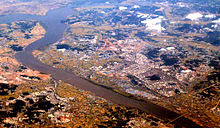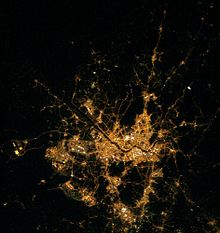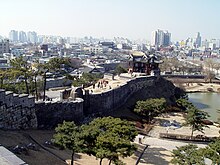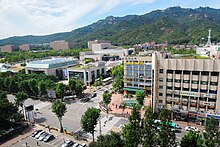Sudogwon
| Korean spelling | |
|---|---|
| Korean alphabet : | 수도권 |
| Hanja : | 首都圈 |
| Revised Romanization : | Sudogwon |
| McCune-Reischauer : | Sudogwŏn |
The term Sudogwon describes the metropolitan area of the South Korean capital Seoul . Sudogwon can be seen as the expanded economic, cultural and political center of South Korea .
With 25.6 million inhabitants (as of 2012) Sudogwon is one of the largest metropolitan areas in the world . 48.6% of South Korea's residents live in this region and it is forecast that the proportion will soon rise to over half. No other metropolitan area in the larger industrial countries (apart from city states) has such a high proportion of the population of the respective state (cf. Vienna 27.5%, Paris 18.8%, Rhine-Ruhr 12.4%).
definition
Although there is no clear definition of Sudogwon, the term generally refers to three administrative units: the cities of Seoul and Incheon , and the province of Gyeonggi-do . Since Seoul and Incheon are like enclaves within Gyeonggi-do, the generally accepted equation of the area of Gyeonggi-do and that of Sudogwon applies. For this reason the region was traditionally called Gyeonggi jibang ( 경기 지방 , 京畿 地方 'Gyeonggi region' ). The province of Gyeonggi-do and its meaning have been historically associated with Seoul for a long time - as the name Gyeonggi expresses, which includes the Hanja character for Seoul or capital ( 京 gyeong ). The term Sudogwon (literally: 'capital district' or 'capital area') has taken over this meaning of the expression Gyeonggi jibang in the last few decades and almost replaced it in common parlance. However, since the word Sudogwon is a relatively modern name, it is used extensively in an economic and political context - the word Gyeonggi Jibang, on the other hand, more in historical and cultural.
In principle, the definition of Sudogwon is not fixed, but depends on the respective context. Especially since the area in question is expanding, as the metropolitan area is currently expanding. For example, the city of Cheonan has recently been seen as part of the region since the Seoul subway network was expanded there in 2005, increasing the number of commuting residents. Cheonan is located in the north of Chungcheongnam-do Province - not far from the border with Gyeonggi-do - and is considered a university and educational city.
development
Original scope


Originally, the term Sudogwon primarily referred to the capital Seoul, the two nearby cities Incheon and Suwon (the seat of the provincial government) and a few other satellite cities that were accessible by local transport. The two traffic axes Seoul-Incheon ( Gyeongin ) and Seoul-Suwon ( Gyeongsu ) played an important role in the history of industrialization .
expansion
The central importance of Seoul, which extends in many national areas, has already attracted members of the younger generation from the provinces since the post-war period. Due to the increasing development of the megacity since the eighties and nineties, the demand for living space increased exponentially and with it the housing prices also went up. To relieve the overcrowded capital, surrounding satellite cities were expanded and planned. While the younger residents moved to the satellite cities mainly because of the lower housing prices, members of the older generation did so in search of a better quality of life, as the satellite cities that were created on the basis of planning were more well-kept and larger than the naturally grown capital.
The two planned cities of Bundang ( Seongnam City ) and Ilsan ( Goyang City ) are among the first two major projects that were initiated primarily to stabilize apartment prices in Seoul. Together, the two cities took over almost half a million residents from the capital. However, these two developed into homes for the affluent class and consequently did not contribute to the price reduction in the real estate market, as was originally expected.
In order to lower real estate prices, more planned cities were built in the new millennium, which had the characteristics of typical satellite cities . As with the two previous models, Bundang and Ilsan, it was mainly a matter of establishing new districts in existing cities. Most of the new districts were connected to the capital's arteries. Examples of cities and their newly planned neighborhoods are:
- Incheon : Incheon Free Economic Zone ( New Songdo City , Yeongjong , Cheongna International City )
- Seongnam : Bundang , Pangyo (under construction)
- Goyang : Ilsan New Town , Deogyang
- Yongin : Suji , Jugjeon, Gwanggyo (under construction, together with the city of Suwon)
- Suwon : Yeongtong, Gwanggyo
- Anyang : Pyeongchon
- Bucheon : Jungdong
- Gwangmyeong
- Gimpo
- Gwangju
- Namyangju
- Hwaseong : Dongtan, Byeongjeom
With the progressive networking of local transport - between the new cities and Seoul as well as the new cities among themselves - the function of Seoul grew not only as a national but also as a regional center. The regional function of Seoul extended to almost the entire province of Gyeonggi-do . On the other hand, the province benefits from the fact that various economic and academic institutions of national and regional importance have been relocated from Seoul to other cities in Gyeonggi-do. A typical example is the construction of Incheon Airport in the city of Incheon , after which the airport is named. Incheon Airport replaced Gimpo Airport , which was located in Seoul and served as an international airport from 1958 to 2001 .
The population of the suburban Gyeonggi-do province is growing from two directions: on the one hand from the densely populated capital and on the other hand from other regions of the country. Residents from other provinces come to the capital or the surrounding metropolitan area in search of jobs.
Most important cities
- Seoul ( 서울 ), capital of South Korea and metropolitan area
- Incheon ( 인천 ), South Korea's third largest city and port metropolis
- Suwon ( 수원 ), provincial capital of Gyeonggi-do and a city of millions
- Gwacheon ( 과천 ), seat of the Gwacheon government complex
- Bucheon ( 부천 )
- Seongnam ( 성남 )
- Yongin ( 용인 )
- Goyang ( 고양 )
- Anyang ( 안양 )
- Pyeongtaek ( 평택 )
- Ansan ( 안산 )
- Uijeongbu ( 의정부 ), seat of the northern provincial government of Gyeonggi-do
traffic

In addition to eight subway lines in Seoul , which extend well beyond the city limits, two more rapid transit lines ( Bundang and Shinbundang Line ) have been built that connect the various districts and quarters in Gyeonggi-do to Seoul. Rail and motorway networks in this region are constantly being expanded and linked.
A general problem, however, is the lack of infrastructure, especially in the transport sector, which was unable to keep pace with the explosive population growth in the densely populated areas. The traffic jam is notorious at rush hour, especially in the direction of Seoul.
On traditional holidays such as Chuseok and Seollal , there is an oversized traffic chaos with a journey time three to four times longer. The traffic jam forms at the beginning of the holidays in the south towards the provinces and at the end in the north towards Seoul.




